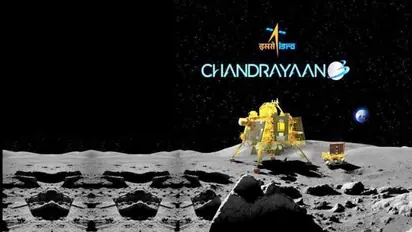ISRO reveals reason behind 4-second delay in Chandrayaan-3 launch; highlights space traffic surge in 2023

Synopsis
In 2023, 3,143 new objects were recorded from 212 launches and on-orbit breakup events globally, compared to 2,533 objects from 179 launches in 2022.
India's Chandrayaan-3 moon mission faced a four-second delay during launch, revealed in a recent report by the Indian Space Research Organisation (ISRO). This delay was implemented to mitigate potential collisions with debris and satellites.
S Somanath, the chairperson of ISRO, presented the Indian Space Situational Assessment Report (ISSAR) for 2023, a comprehensive overview of the space environment on Friday. Compiled by the ISRO System for Safe and Sustainable Space Operations Management (IS4OM) on April 2, the report sheds light on key aspects of space operations.
The report stated, "For LVM3-M4/ Chandrayaan-3, the nominal lift-off had to be delayed by 4 seconds based on COLA analysis to avoid close approaches between a debris object and the injected satellites in their orbital phase due to overlapping operational altitudes."
The report emphasized the susceptibility of space assets to a range of environmental hazards, including asteroids, comets, meteoroids, and artificial space objects.
"Space assets operating in outer space are vulnerable to various environmental hazards- natural objects like asteroids, comets, and meteoroids, energy and particle flux, and artificial space objects. Therefore, continual awareness of the space environment and its future evolution, namely Space Situational Awareness (SSA), becomes an essential pre-requisite for safe and sustainable operations in outer space. ISRO’s SSA activities include close approach assessment of satellites and launch vehicles, prediction of atmospheric re-entry, the study of the evolution of space object population to safeguard national space assets, and also promoting responsible behaviour while conducting operations in outer space," the report stated.
3,143 new objects added in space last year, ISRO avoided 23 collisions
In 2023, 3,143 new objects were recorded from 212 launches and on-orbit breakup events globally, compared to 2,533 objects from 179 launches in 2022. This surge in space traffic raises concerns about the heightened risk of collisions with operational satellites.
India conducted seven successful ISRO missions during the year, deploying five Indian satellites, 46 foreign satellites, and eight rocket bodies into orbit. However, the nation also had to execute a record number of collision avoidance maneuvers (CAMs) for its operational satellites due to close encounters with other space objects.
The ISSAR report notes an increasing trend in collision avoidance maneuvers (CAMs) per year, attributed to the growing congestion in outer space. In 2023, there were 3,033 close approach alerts within 1 km detected for ISRO satellites. Although no actual collisions occurred, the report underscores the importance of responsible behavior and coordination among space operators to mitigate risks. Some ISRO mission launch timings had to be adjusted based on collision avoidance analyses to evade potential close encounters.
By the end of 2023, 21 Indian satellites reentered Earth's atmosphere, with eight undergoing reentry in that year alone. Notably, the controlled reentry of the Megha-Tropiques-1 satellite stood out as a meticulously planned and highly challenging operation.
The report disclosed that a total of 82 rocket bodies from Indian launches had been placed in orbit by the end of 2023. Notably, in 2001, the upper stage of the PSLV-C3 rocket inadvertently broke up, generating 371 fragments of debris. While most of these pieces have since reentered the atmosphere, 52 debris from PSLV-C3 remained in orbit until the end of 2023.
Regarding intact Indian upper stages, 35 rocket bodies had reentered Earth's atmosphere by the end of 2023, with five such occurrences transpiring in 2023 alone.
Additionally, ISRO received over 1.3 lakh close approach alerts from the United States Space Command (USSPACECOM). These alerts were further assessed using more precise orbital data of Indian operational satellites.
"A total of 3,033 alerts were detected for close approaches within a distance of 1 kilometer, and around 2,700 close approaches were observed with other operational satellites within a 5-kilometer range," it said as quoted in a TOI report.
In specific cases, coordination took place with international agencies like SpaceX and EUMETSAT to manage potential close approaches. However, none of these encounters were deemed critical enough to necessitate a collision avoidance maneuver (CAM).
Throughout 2023, ISRO conducted a total of 23 CAMs to safeguard its space assets, marking an increase from 21 CAMs in 2022 and 19 in 2021.
No significant close approaches were detected for Chandrayaan-3 during its mission phases or for Aditya-L1 during its Earth-bound phase.
The report underscores the necessity for Space Traffic Management in an environment increasingly populated by active satellites. It advocates for the establishment of a universally accepted framework and the adoption of best practices to ensure the long-term sustainability of space activities.
As the space sector burgeons with more participants and ambitious endeavors such as mega-constellations and space tourism, innovative solutions like active debris removal and on-orbit servicing will be imperative for ensuring safe and sustainable operations amidst the escalating congestion in space.
Stay updated with the Breaking News Today and Latest News from across India and around the world. Get real-time updates, in-depth analysis, and comprehensive coverage of India News, World News, Indian Defence News, Kerala News, and Karnataka News. From politics to current affairs, follow every major story as it unfolds. Get real-time updates from IMD on major cities weather forecasts, including Rain alerts, Cyclone warnings, and temperature trends. Download the Asianet News Official App from the Android Play Store and iPhone App Store for accurate and timely news updates anytime, anywhere.